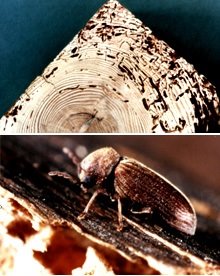 Once the wood had been sandblasted to clean of any varnish or paint, we started the treatment against the woodlice. The most common methods are:
Once the wood had been sandblasted to clean of any varnish or paint, we started the treatment against the woodlice. The most common methods are:Anti-return valves
It’s one of the oldest and most effective methods to treat installed woodworks. The valves are introduced into a series of holes previously drilled into the beams. With the help of a pump, the insecticide is injected through pressure into the beams. (Garbi S.L.)
The advantage of this method is that you don’t have to strip the beams of any paint but on the other hand the method is quite aggressive and labour-intensive. The holes that need to be drilled into the wood have an approximate diameter of 1 cm and have to be closed up with wax for example, at the end.
Impregnation
This method consists in spraying the whole surface of the wood that needs to be treated. Normally, using special spraying equipment, liquids or gels can be applied. (Garbi S.L.)
The controlled spraying with pressure of a low-toxic insecticide permits a quick and very efficient job in case of well-cleaned wood.
In our case we opted for the impregnation method with a new-generation low-toxic insecticide gel. The company Garbi offered us this treatment with a 10 year guarantee that no woodlice will return. They applied the gel to the wood with a pump capable of spreading the insecticide evenly, which at first leaves a visible layer of a few millimetres but which gradually gets completely absorbed by the wood. This method has a very localised application system without creating toxic fumes but let’s you back into your flat after a few hours. No need for quarantine here.

No comments:
Post a Comment